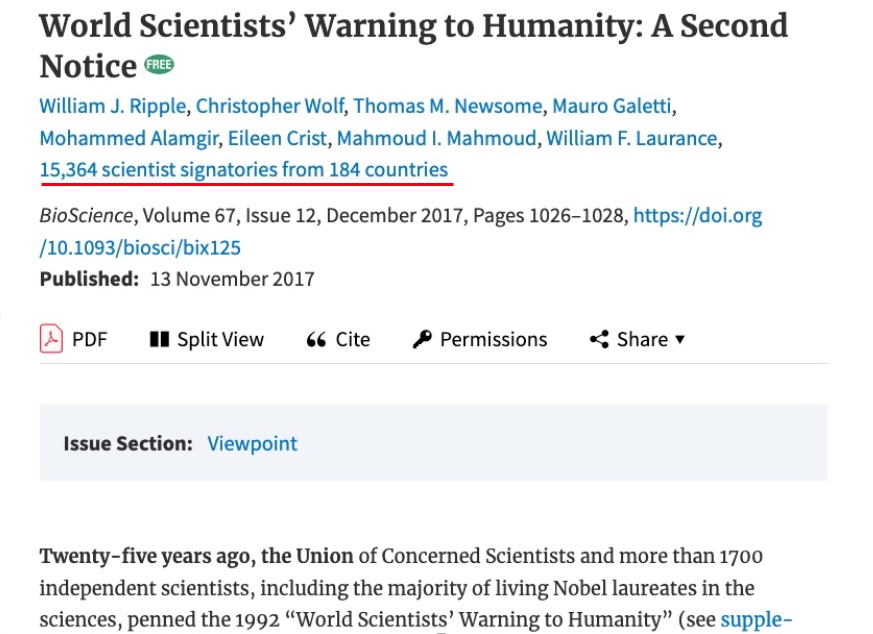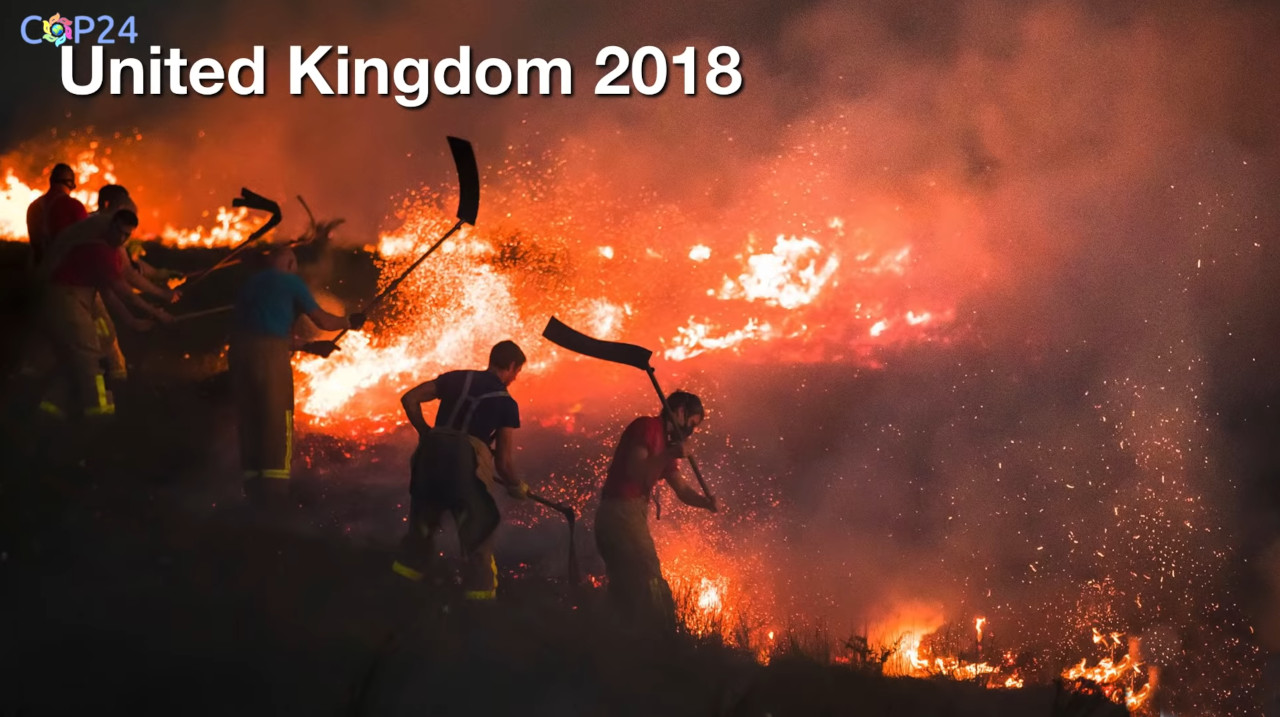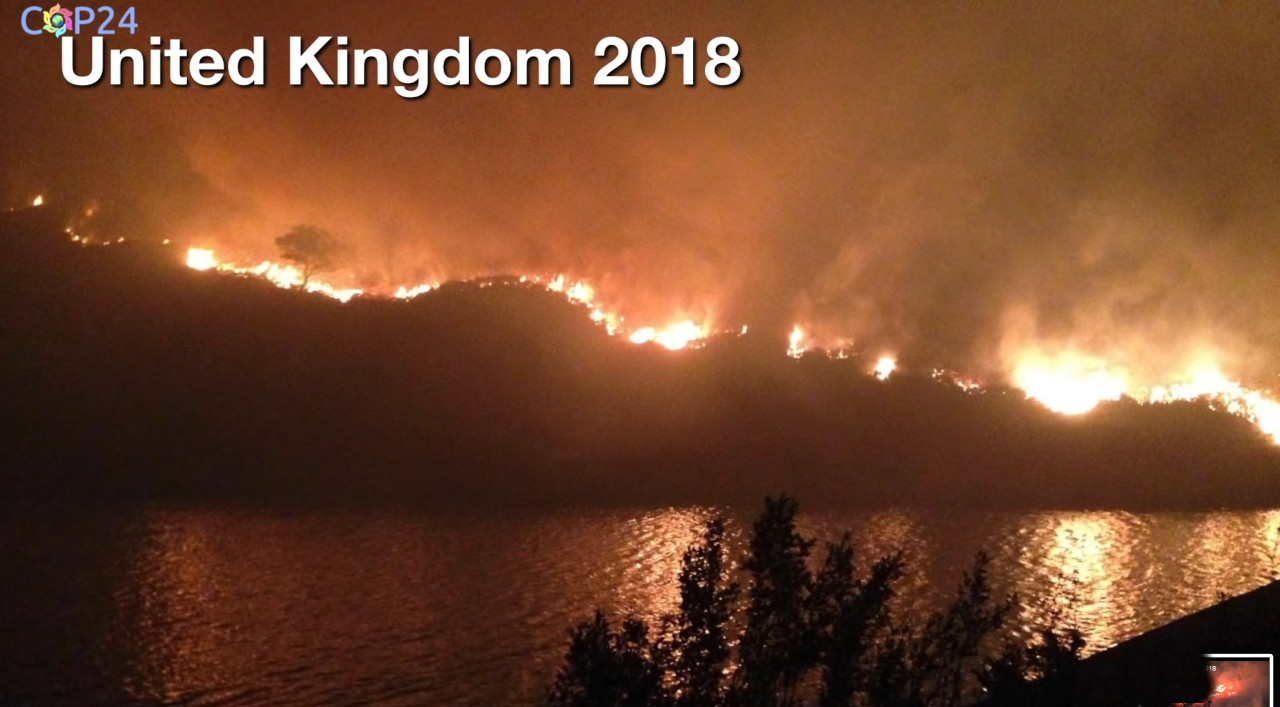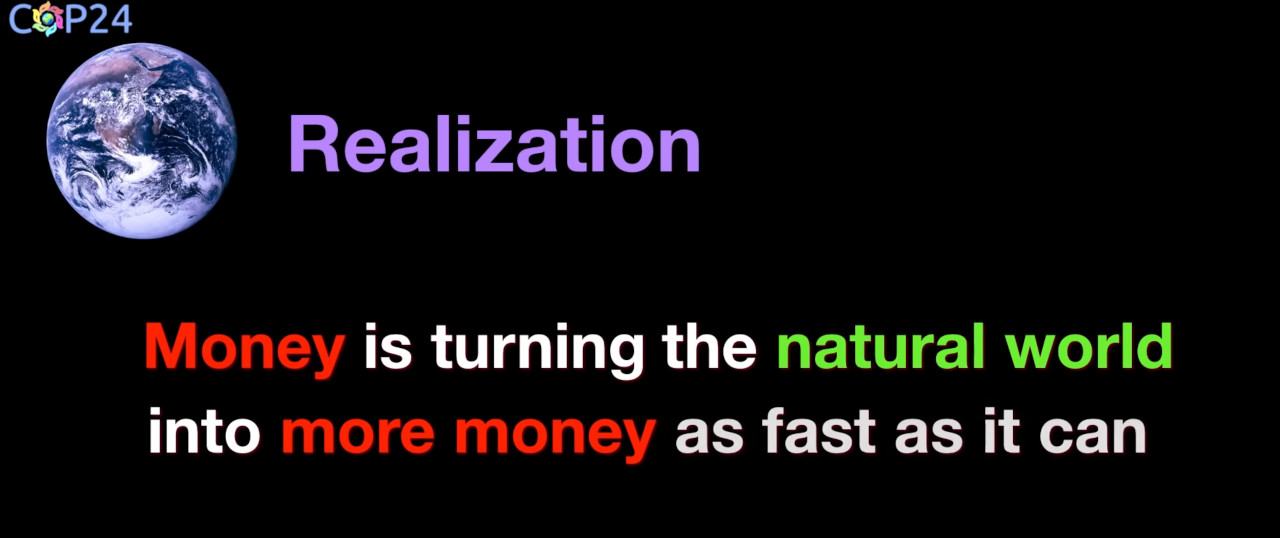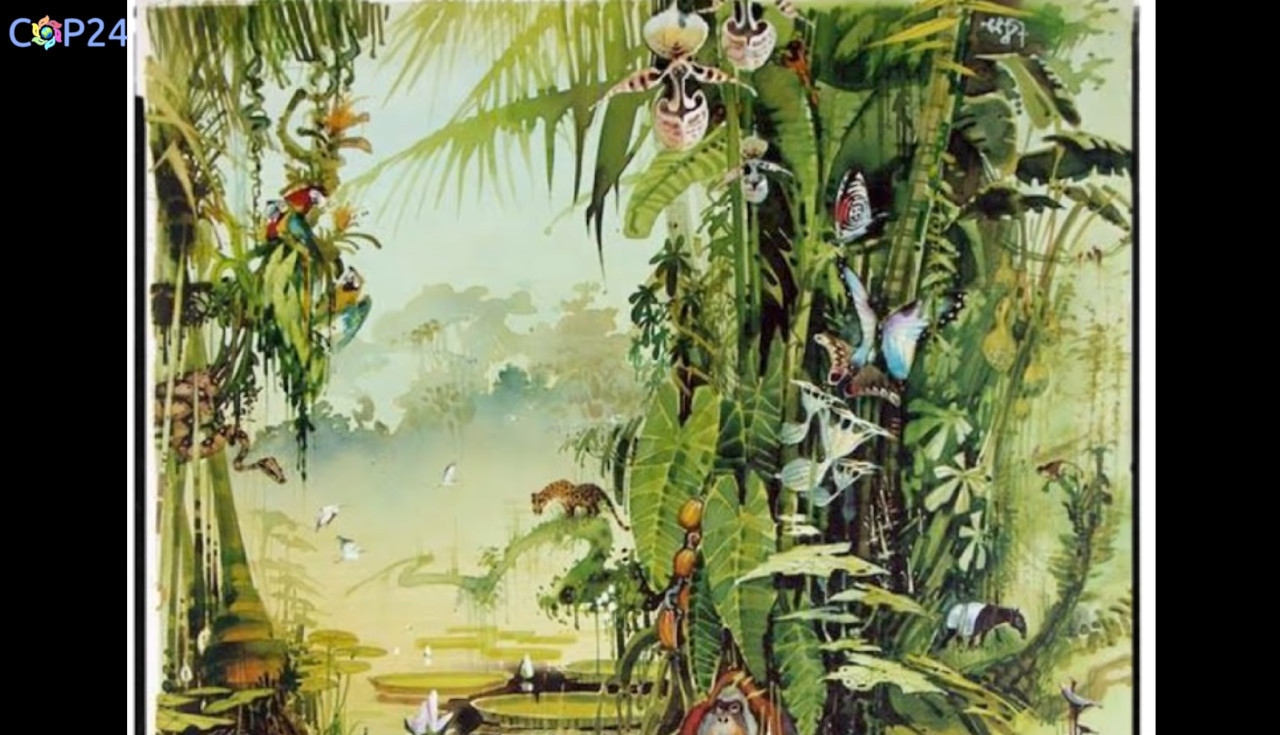Very strong language. So did we change? Not much. Unfortunately our leaders did not take heed. Other things were pre-emptive in their minds than taking care of our common home.
Fast forward, 25 years in late 2017, another group of scientists published this peer-reviewed scientific paper in BioScience. At its publication, it had been signed by over 15,000 scientists from around the world and an additional 8,000 or so have signed it since. It holds records in terms of the number of scientists who’ve signed it in citations. It is a very, very, powerful statement. But again, it does not seem to be that we are taking heed.It made reference to the first Scientists’ Warning and this one was called: “A Second Notice”. My own feeling is that it should have been called: “Final Notice”. I’m not sure we’ll get another chance.
So, I’d like to go in very briefly to the ecological stressors that were cited by this Second Warning, the second notice.
First, Biodiversity Loss, and let me say a bit more about that later.
Food Systems—our food system is said to be accountable for about a third of all carbon dioxide emissions. When you consider how food is grown, how it’s transported, how it’s refrigerated, how it’s wasted, how it’s disposed of—about a third of all carbon dioxide emissions.
[Victoria Hurth:] If I could just add to that, Stuart, actually, the large majority is the fertilizers from the fossil fuel fertilizers and a lot of people don’t actually consider that. And those fertilizers have other problems also because they pollute our Fresh Water—all of these are interrelated.
Those fertilizers contribute to Marine Life Depletion and Ocean Pollution. They create dead zones at the mouths of major rivers where the excess fertilizer washes out.
We’re Destroying our Forests at an incredible rate -- both man-made destruction and now nature has taken over. We are Toxifying the Air that we breathe. I don’t call it air pollution because we’ve become calloused to that notion—air pollution. Well, we all live with air pollution. Air pollution creates lower birth weight babies and it creates alzheimer’s and dementia in our seniors. So we are toxifying the air we breathe.
We are Degrading Soils around the planet at an incredible rate—losing 30 billion tons of topsoil every year, it’s estimated.
Population is the elephant in the room. Few, if any, politicians will talk about it. You cannot expect to get reelected on a platform of limitations to population, but as you’ll see it’s a major, major problem.
Climate Change is the big one—it’s the tsunami coming at us, and that’s why we’re here. We have this ritual for the past 25 years of getting together, having a huge carbon footprint, building these temporary buildings, throwing it all away at the end of two weeks in an effort to reduce our carbon emissions. Is there something wrong with this picture? And how much have we accomplished in those 25 years?
But first, Biodiversity Loss. The source of this data is the World Wildlife Fund and the UN Environment Program itself. This was a graph that I found and when I extended it out extrapolated to 2018 by those same sources, we have seen a 60% loss of the biomass of all vertebrate species. Now, we’re not talking about extinctions. We’re talking about the loss of the numbers as well as extinctions. Incredible. When you look at the insect population, it’s estimated to be about 70 to 75% of all insects have been lost.What does that mean for us? When you consider that insects are the base of the food chain, when you consider that they are the pollinators for many of our crops, we are committing suicide, ecocide.
Unfortunately, much of humanity has this view of the problem of biodiversity loss. As long as I have my burgers and McNuggets, what do I care? How many species do I need? This is a bad attitude. It’s incorrect mentality, but it is fostered in most industrialized nations. Now I’m going to skip to Population and I’m going to show just one slide: what the human population is estimated to have been and then calculated to have been over the past 10,000 years. Kind of shocking.Now I know most of us in this room have some concept of that, but my challenge is, Is it even possible to discuss sustainability in this context? And UN sources estimate we are looking at 9 or 10 billion people by mid-century. Already systems are collapsing,
But let’s take a look at Climate Change. Now I want to show you four maps of the earth. They are drought maps, but I want you to note the scale. The scale is one of relative drought. So the red to purple and pink indicate extremely, unusually dry areas. If you take a look at the Sahara, It’s green and yellow. That doesn’t mean it was moist—it means it was normally dry in the Sahara.The other end of the scale, there are a couple of places that are dark blue where there was more rain—lots more happening than usual. But take a look at the one-third point, two-thirds point and final decade of this century:
2030 through 39, 2060 through 69 and 2019 through 99.But we don’t have to go all the way out to the end of the century to see what the problem is. And one of the mistakes that we are making is that we are talking about the year 2100 or we’re talking about the year 2050; The effects will be.
We will see very drastic consequences much, much sooner than that. We already are seeing drastic consequences because when farms get dry, they wilt.
This is The Netherlands in the growing season of this year, Germany’s potato crop, grain in Germany, Grain in Denmark —and that photograph came from this article online [Record drought in Denmark causes 40% drop in crop yield, $1billion in losses, and wave of bankruptcies], which cited the figure that 40% of the crop yield was lost this year in Denmark. Same in Sweden—billion dollar losses, many bankruptcies. That was this summer’s weather map. When forests get dry, they don’t wilt, they burn. This year—early this year in California, historic fires in Greece, in Japan—not known for wild fires, in Siberia—not known for wild fires, in Canada, ditto. The UK this year in Lancashire—not known for wild fires. This was on their Moors. Again in California, still smoldering. Incredible loss of life and property, but the property is always mentioned first. Though I shouldn’t say always, but if you take a look, that’s what makes headlines—billions of dollars in loss. You know that fire is good for the US GDP because all of those buildings have to be replaced. An oil tanker which sinks creates more GDP than one that arrives safely at its destination. Is that perverse? Sweden burning this year—historic wildfires. Denmark. Now, to understand climate change clearly I want to show you the heat effect of our past CO2 emissions. They produce this much heat—Leading to this kind of headline, which is now becoming more and more common from Bloomberg Businessweek:
“New Climate Debate: How to Adapt to the End of the World”.
Researchers are thinking about social collapse and how to prepare
for it.
“social collapse and how to prepare for it”
We’ve reached a different stage in our awakening to this problem. Of course, governments still kick the can down the road whenever they can. You’ll forgive me, but that’s what I see these negotiations about. They are not being conducted in good faith by the parties. Some parties really see the problem and a lot of parties, they have another master and we’ll get to that one now.
My thesis—I teach this every chance I get—is that global civilization has an operating system. I don’t know anyone else who teaches about our global operating system. It is seriously—no disastrously—flawed. Our operating system is killing us. Now, what is that operating system? It’s known by two common names: Money and Economics. But not just Economics. It’s a brand of economics—Neoclassical Economics. Also known as Growth Economics. Also known as Mainstream Economics.The name “Neoclassical” dropped out of the record about a hundred years ago when JP Morgan staged what’s known as the neoliberal coup at the University of Chicago and a neoclassical economist was installed as the Chair of the Economics Department. And very soon, nothing was being taught but this kind of economics. Which just happens to be the one that benefits bankers the most.
A hundred years later, it’s the only thing we know and we call it simply economics. We’ve been hoodwinked. We continue to be hoodwinked. Every day when you hear that word, think Neoclassical Growth Economics and it puts everything into perspective.
Let’s take a look at money. Money is a virus of the human mind. Money is using humanity as its host for its own reproduction. This is the way it behaves. Now the first President Bush, President George Herbert Walker Bush, was known to have said, “If it looks like a duck and quacks like a duck, it is a duck.” I think that he borrowed that from somebody. If money looks and behaves like that, can it be far from that? Money is turning the natural world into more money as fast as it possibly can. It’s turning this into this with utmost speed. The strangest part is that money prevents most of us from even seeing that as a problem. In mainstream economics, Nature is an ‘externality’. This is what’s taught in most business schools—it doesn’t matter that we are destroying nature.In fact, the gentleman who won this year’s fake economics prize, Nobel economics prize. It’s not a real Nobel Prize. It was financed by the Central bank of Sweden in 1968 and they made it a Nobel Prize.
This year’s winner said, “Climate change doesn’t really matter because agriculture is only 2% of our global GDP, so if agriculture is harmed, it won’t harm our GDP much.” Excuse me? Won’t harm our GDP much? What are we going to eat—money?
The sustainable development goals, I will attack them. I will attack one of them. There are only 16 and a half of them there. Number eight is a piker in American English. Decent work. Yes. Economic growth. No. Now, it’s worded “Economic growth in developing nations.” Yes, but only if developed nations will slow down their growth. And do you think any developed nation is willing to do that? Hey, if they can grow up, why can’t we?Again, is that the platform you want to get re-elected on? We’re gonna slow growth so that they can grow in the least developed nations? From the poorest to the richest—money owns us not the other way around.
Now, I’m going to very quickly cover some interventions. Civil Disobedience. The time has come for massive civil disobedience.
This is Greta Thunberg. She became world famous overnight. She inspired 29—there are 21 shown here. It’s increased to 29 cities in Australia where the students are going out on strike every Friday. This is upsetting the politicians who are demanding they go back to school. Excuse me, while you screw up our future?
The Extinction Rebellion, which started in the UK this year took over five of the bridges crossing the Thames. Peaceful civil disobedience—in growing numbers. I like to reframe it as “Unite for Life,” but if it takes a rebellion at this point, so be it.
Lawsuits. Time has come to sue our governments and corporations. Urgenda won against the Netherlands earlier this year, actually just in November. They were supported by huge marches.
This is the action going on in the United States, Juliana vs US government and there Jim Hansen in the back row. Twenty youths and Jim Hansen, and that’s their lawyer on the extreme left of that photo.
Obama could have settled this. When Trump was elected before Obama left office. Obama could have settled this. Hansen went to him and said, ‘Settle the suit now.’ Whoever was advising Obama—I don’t know what they were smoking, but Obama said, “No”.
You don’t have to sue at a national level. You can sue at a local level. These children are suing the State of Washington in the United States.
My premise here is that we must change “business as usual,”

